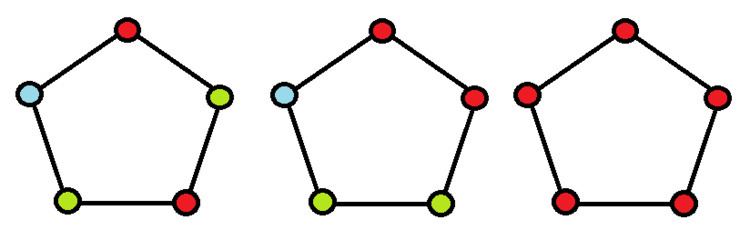 | ||
In graph theory, a mathematical discipline, coloring refers to an assignment of colours or labels to vertices, edges and faces of a graph. Defective coloring is a variant of proper vertex coloring. In a proper vertex coloring, the vertices are coloured such that no adjacent vertices have the same colour. In defective coloring, on the other hand, vertices are allowed to have neighbours of the same colour to a certain extent. (See here for Glossary of graph theory)
Contents
History
Defective coloring was introduced nearly simultaneously by Burr and Jacobson, Harary and Jones and Cowen, Cowen and Woodall. Surveys of this and related colorings are given by Marietjie Frick. Cowen, Cowen and Woodall focused on graphs embedded on surfaces and gave a complete characterization of all k and d such that every planar is (k, d)-colorable. Namely, there does not exist a d such that every planar graph is (1, d)- or (2, d)-colorable; there exist planar graphs which are not (3, 1)-colorable, but every planar graph is (3, 2)-colorable. Together with the (4, 0)-coloring implied by the four color theorem, this solves defective chromatic number for the plane. Poh and Goddard showed that any planar graph has a special (3,2)-coloring in which each color class is a linear forest, and this can be obtained from a more general result of Woodall. For general surfaces, it was shown that for each genus
Defective coloring
A (k, d)-coloring of a graph G is a coloring of its vertices with k colours such that each vertex v has at most d neighbours having the same colour as the vertex v. We consider k to be a positive integer (it is inconsequential to consider the case when k = 0) and d to be a non-negative integer. Hence, (k, 0)-coloring is equivalent to proper vertex coloring.
d-Defective chromatic number
The minimum number of colours k required for which G is (k, d)-colourable is called the d-defective chromatic number,
Impropriety of a vertex
Let c be a vertex-coloring of a graph G. The impropriety of a vertex v of G with respect to the coloring c is the number of neighbours of v that have the same color as v. If the impropriety of v is 0, then v is said to be properly colored.
Impropriety of a vertex-coloring
Let c be a vertex-coloring of a graph G. The impropriety of c is the maximum of the improprieties of all vertices of G. Hence, the impropriety of a proper vertex coloring is 0.
Example
An example of defective colouring of a cycle on five vertices,
Properties
Every outerplanar graph is (2,2)-colorable
Proof: Let
Corollary: Every planar graph is (4,2)-colorable. This follows as if
Graphs excluding a complete minor
For every integer
Computational complexity
Defective coloring is computationally hard. It is NP-complete to decide if a given graph
Applications
An example of an application of defective colouring is the scheduling problem where vertices represent jobs (say users on a computer system), and edges represent conflicts (needing to access one or more of the same files). Allowing a defect means tolerating some threshold of conflict: each user may find the maximum slowdown incurred for retrieval of data with two conflicting other users on the system acceptable, and with more than two unacceptable.
